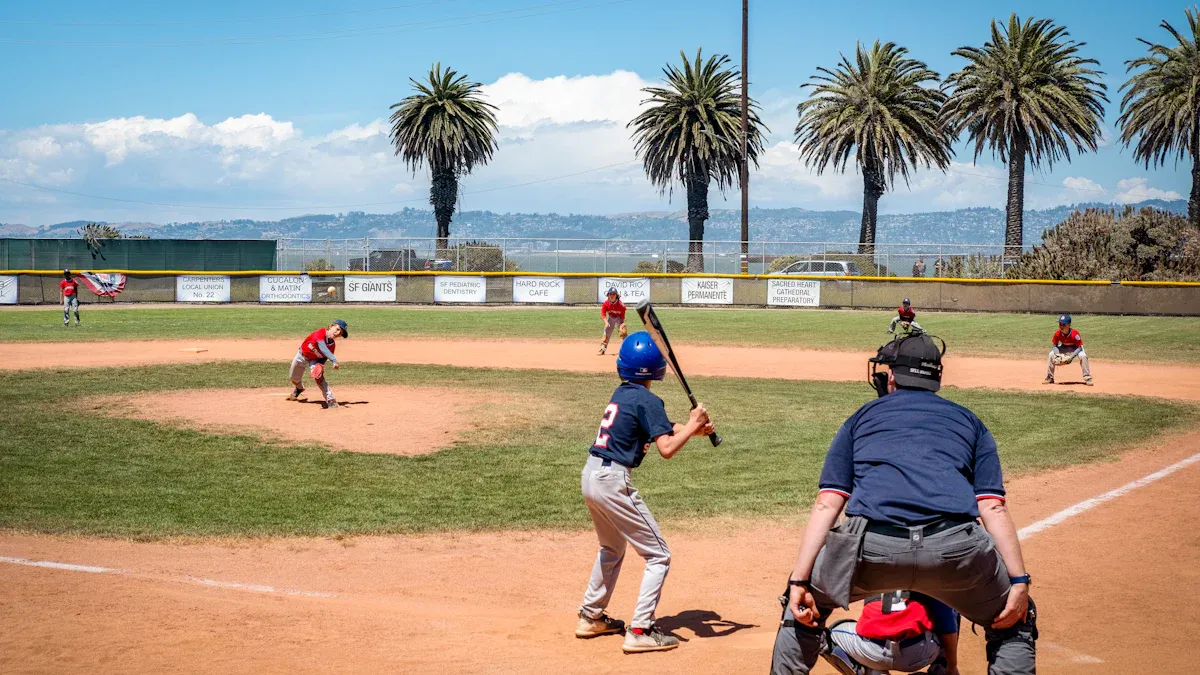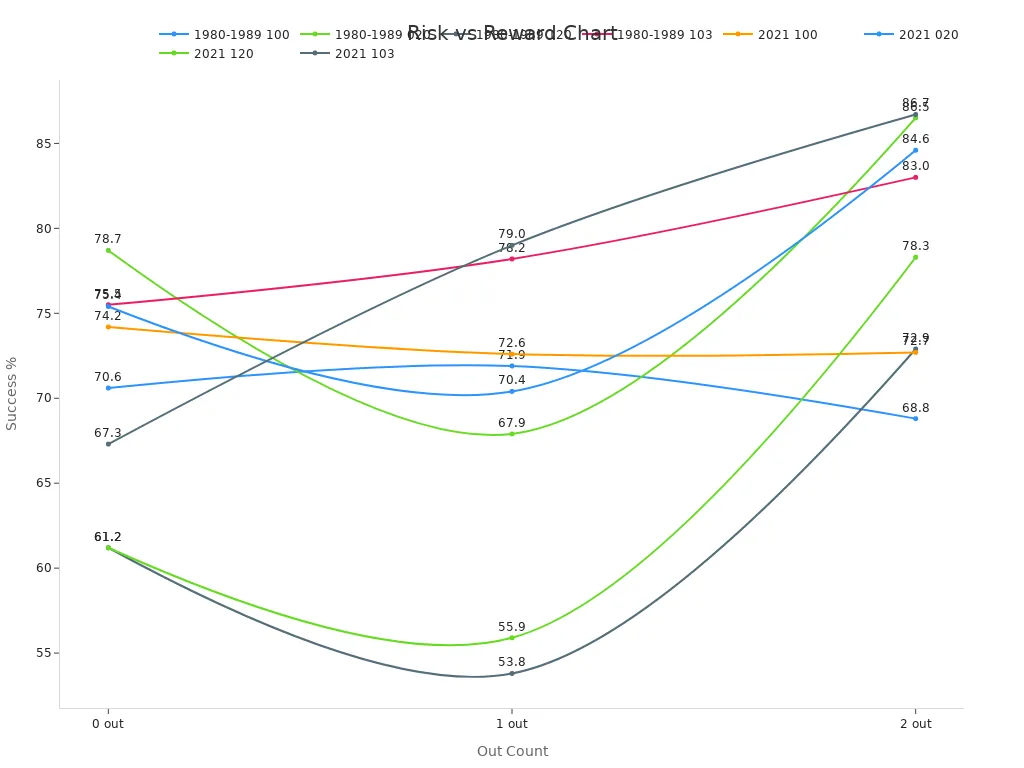
In baseball, ‘CS in baseball’ stands for ‘Caught Stealing.’ It tracks the instances when a runner attempts to steal a base but is tagged out. This statistic highlights how players manage risks while stealing bases and provides insight into their baserunning abilities. For instance, in 2012, MLB teams achieved a 74% success rate for stolen bases, slightly below the break-even point of 74.7%. The data suggests that stolen bases contribute minimally to scoring. ‘CS in baseball’ plays a crucial role in evaluating strategy and efficiency within the game.
Key Takeaways
Caught Stealing (CS) tracks when a runner tries to steal a base but gets tagged out. This statistic helps evaluate a player’s baserunning skills.
A high CS rate can hurt a player’s reputation. Players need to steal bases successfully at least 70% of the time to be seen as effective.
Teams analyze CS data to improve their strategies. Understanding when to attempt a steal can significantly impact a team’s scoring chances.
Caught stealing affects a team’s chance to score. For example, getting caught with no outs drops the scoring chance from 95.3% to 29.7%.
Learning about CS helps players and teams balance risk and reward in baserunning. Smart decisions lead to better outcomes on the field.
What Is CS in Baseball?

Definition of ‘Caught Stealing’
In baseball, “caught stealing“ happens when a runner tries to move to the next base without a hit but gets tagged out. This shows the risks of stealing bases and helps measure how good a player is at running bases. The MLB started keeping track of caught stealing in 1951, making it important for judging baserunning skills.
A runner is marked as caught stealing if they try to steal a base and are put out. This includes being caught in a rundown or tagged while advancing. Even if a defensive mistake lets the runner reach the base safely, it still counts as caught stealing if they would have been out without the error. These rules make sure the stat reflects the real result of a stolen base try.
Did You Know?
Caught stealing is not counted during a dead ball or when the defense doesn’t try to stop the runner. This is called “defensive indifference.”
How CS is recorded in baseball statistics
Recording caught stealing follows clear rules to keep stats consistent. Here’s how it works:
It’s recorded when a runner tries to steal but is tagged out.
If a wild pitch or passed ball lets the runner move, it’s not a stolen base unless they started running before the ball got away.
If a defensive error lets the runner reach safely, it still counts as caught stealing if they would’ve been out otherwise.
No caught stealing is recorded during a dead ball.
Defensive indifference, where the defense doesn’t try to tag the runner, doesn’t count as a stolen base or caught stealing.
Rule Description | Notes |
|---|---|
A runner is charged with caught stealing when trying to advance without a hit and is tagged out. | This includes being put out during a stolen base attempt or caught in a rundown. |
MLB started tracking caught stealing in 1951. | Official MLB rules explain when caught stealing is recorded. |
A runner is charged with caught stealing if: | 1. They try to steal and are put out. 2. They are caught in a rundown and tagged out. 3. They are safe due to an error but would’ve been out otherwise. |
These rules make sure caught stealing stats show a player’s baserunning choices. By learning how CS in baseball is tracked, you can better understand the risks and strategies of stealing bases.
How Is CS Calculated?
Tracking a caught stealing event
To figure out “Caught Stealing” (CS), you watch baserunning events. A runner gets a CS if they try to steal a base but are tagged out. This includes being caught in a rundown or losing to the catcher’s throw. The stat records every failed stolen base attempt.
Baseball experts use math to check baserunning success. For example, Stolen Base Percentage (SB%) shows how often a player steals bases successfully. It’s found by dividing successful steals by all attempts (successful steals + caught stealing). Another stat, Stolen Base Runs (SBR), measures how stolen bases add to runs. Its formula is:(0.3 x Stolen Bases) - (0.6 x Caught Stealing).
Statistic | Formula |
|---|---|
Stolen Base Percentage | Successful Stolen Bases / Stolen Base Attempts |
Stolen Base Runs (SBR) | (0.3 x Stolen Bases) – (0.6 x Caught Stealing) |
These numbers help teams decide if stealing bases is worth the risk.
Examples of caught stealing moments
Real examples of caught stealing show how it happens in games. One famous moment was in the World Series when Hi Myers tried to steal but got tagged out. Another case is Ty Cobb, a great baserunner, who was caught stealing often because he took big risks.
Player | Scenario | Outcome |
|---|---|---|
Hi Myers | World Series attempt | Caught stealing |
Ty Cobb | Multiple attempts | Caught stealing |
These stories show how close success and failure can be in baserunning. Even top players can fail when taking chances. By learning from these examples, you’ll see why CS matters in baseball strategy.
Why Does CS Matter in Baseball?
How It Changes Baserunning Plans
Caught stealing (CS) changes how teams and players run bases. Trying to steal a base is risky. If a runner gets caught, it lowers the team’s chance to score. For example, if a runner on first base with no outs gets caught, the team’s chance to score drops from 0.953 to 0.297. This big drop shows why teams must think carefully before trying to steal.
Teams study caught stealing stats to improve defense. A high caught stealing rate means strong defense. Look at the table below:
Team | Stolen Bases Allowed | Caught Runners | Caught-Stealing Percentage |
|---|---|---|---|
Kansas City Royals | 35 | – | – |
Seattle Mariners | – | 30 | – |
Detroit Tigers | – | – | 33% |
San Francisco Giants | 93 | – | – |
Texas Rangers | – | 12 | 14% |
Chicago Cubs | – | 12 | 14% |
St. Louis Cardinals | – | – | 14% |
Los Angeles Dodgers | 29 | 17% | |
Tampa Bay Rays | – | – | 17% |
Washington Nationals | – | – | 17% |
Chicago White Sox | – | – | 17% |
2024 Dodgers | 106 | 39 | – |
This table shows teams like the Los Angeles Dodgers and Tampa Bay Rays are great at stopping runners. This makes other teams think twice about stealing bases. By looking at these numbers, teams can change their plans to avoid getting caught.
How It Affects Players’ Choices and Image
For players, caught stealing can hurt their image and choices. A high caught stealing rate shows bad decisions or being too bold. Players who get caught often might not get chances to run. Coaches prefer players who are careful and smart.
The stats explain why this matters. To succeed, a player needs to steal bases 70-75% of the time. But getting caught is much worse than the reward of stealing. For example, a successful steal adds 0.236 runs, but getting caught takes away 0.656 runs. This makes players think hard before trying to steal.
Tip: Players with high stolen base percentages (SB%) are trusted more in big moments. Being smart and balanced helps build a good reputation as a runner.
The chart below shows how caught stealing changes run chances in games:

As shown, getting caught stealing has big effects. For example, when Mitchell was on first base with no outs, his team’s chance to score dropped by 0.6031 runs after he got caught. These examples show why smart choices on the bases are so important.
CS in Baseball vs Related Statistics
CS vs SB (Stolen Bases)
Caught stealing (CS) and stolen bases (SB) are opposites in baseball. SB counts successful steals, while CS tracks failed attempts. Together, they show how good a player is at running bases. For example, in 1962, players had 104 stolen bases but only 13 caught stealing events. By 1965, the numbers changed to 94 stolen bases and 31 caught stealing events. This shows how baserunning success can change over time.
Year | Stolen Bases (SB) | Caught Stealing (CS) |
|---|---|---|
1962 | 104 | 13 |
1963 | 40 | 19 |
1965 | 94 | 31 |
These stats are more than just numbers. Weighted stolen bases (wSB) give a run value to each stolen base and caught stealing. This helps teams see if a player’s baserunning helps or hurts their team.
Understanding SB% (Stolen Base Percentage)
Stolen base percentage (SB%) shows how often a player steals bases successfully. It uses this formula:
SB% = (Stolen Bases) / (Stolen Bases + Caught Stealing)
For example, if a player has 20 stolen bases and 5 caught stealing events, their SB% is 80%. A rate above 70% is the breakeven point, where stealing is worth the risk. In 2024, Statcast data showed an 80.8% success rate overall, with 87% success for valuable steals. This proves SB% helps players and teams make better choices.
Evaluating Baserunning Efficiency with CS
Caught stealing data is key to judging baserunning skill. Metrics like Ultimate Base Running (UBR) and Stolen Bases Above Average (SBAA) use CS data to measure a player’s impact. UBR shows how baserunning affects scoring chances. SBAA compares a player’s stolen base success to league averages. Sprint speed also matters since faster players usually succeed more.
Metric | Description |
|---|---|
UBR (Ultimate Base Running) | Measures how a player’s baserunning changes scoring chances. |
Sprint Speed | Tracks how fast a player runs, helping their baserunning. |
Stolen Bases Above Average | Compares a player’s stolen bases to the league’s average success rate. |
By using CS data with these metrics, teams can learn more about a player’s strengths and weaknesses. This helps improve strategies and team performance.
Strategic Importance of CS in Baseball
Balancing Risk and Reward in Stealing Bases
Stealing bases is risky but can help teams score more runs. A successful steal boosts scoring chances, but getting caught stealing (CS) lowers them. This balance between risk and reward has changed how teams run bases over time.
In the 1980s, players tried to steal bases more often. For example, in 1987, there were 0.85 steal attempts per game. By 2021, this dropped to 0.46 attempts per game. However, success rates improved, going from 70% in the 1980s to 75.7% in 2021. This shows teams now focus on being careful and efficient instead of trying to steal often.

The table below shows how success rates change based on outs:
Year | Runner(s) | 0 out | 1 out | 2 out |
|---|---|---|---|---|
1980-1989 | 100 | 70.6% | 71.9% | 68.8% |
2021 | 100 | 74.2% | 72.6% | 72.7% |
These stats reveal that today’s players steal bases more carefully. They wait for the right moment when the reward is worth the risk.
How CS Data Shapes Team Plans
Caught stealing (CS) stats are key for planning team strategies. Teams study CS numbers to spot patterns in opposing defenses. For instance, if a catcher has a high CS rate, teams might avoid stealing. Instead, they may focus on hits or sacrifice plays to move runners.
Teams also use CS stats to judge their own players. A player with many CS events might get fewer chances to steal. This is because failed attempts hurt the team’s scoring chances. On the other hand, players with high stolen base success rates are valuable in close games where every run counts.
By using CS data wisely, teams can balance bold and safe baserunning. This helps ensure that every steal attempt fits the team’s overall goals.
Caught stealing (CS) in baseball shows the risks of baserunning. It tracks how well players decide when to advance bases. This stat affects their image and helps teams plan strategies. Teams study CS data to improve baserunning and defense.
Jackie Robinson’s career shows how bold baserunning changes the game. His speed and hitting skills made him a legend. He scored over 100 runs in six seasons and stole 197 bases. His style made baseball more exciting, moving away from just power hitting.
CS impacts more than just players. Stats like Secondary Average and Relation to Runs Created show its effect on teams.
Statistic | Description |
|---|---|
Secondary Average | Tracks offense beyond batting average, including walks, bases, steals, and CS. |
Relation to Runs Created | Shows how CS affects total runs a team makes. |
Learning about CS helps you see the strategy in stolen bases. It shows why balancing bold moves with careful planning is key to scoring more runs.
FAQ
What does “caught stealing” mean in baseball?
Caught stealing (CS) happens when a runner tries to steal but is tagged out. It shows the risks of moving bases without a hit. This stat helps measure how skilled a player is at running bases.
How does caught stealing affect a team’s scoring chances?
Getting caught stealing lowers a team’s chance to score a lot. For example, if a runner on first base with no outs gets caught, the chance to score drops from 95.3% to 29.7%. This shows why smart baserunning is so important.
What is a good stolen base percentage (SB%)?
A good SB% is over 70%. This is the breakeven point where successful steals are worth the risk. Players with higher SB% are seen as better and more useful runners.
How do teams use CS data to improve strategies?
Teams study CS data to find patterns in other teams’ defenses. If a catcher has a high CS rate, teams might avoid stealing. Instead, they may use hits or sacrifice plays to move runners forward.
Does caught stealing impact a player’s reputation?
Yes, it does. A high CS rate can mean bad choices or taking too many risks. Players with fewer CS events and higher SB% are trusted more in big moments because they make smarter decisions.
